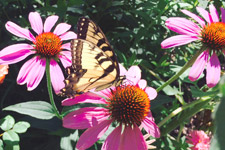
Story & Photo by Linda Wiggen Kraft
Purple coneflower is one of the best-known and best-loved native prairie plants.
Its daisy-like composite shape with its large spiky orange and brown seed heads and pink/purple flower petals is well loved by gardeners living in prairie lands and way beyond those borders. It is also well loved by insects and birds for its nectar and seeds.
Echinacea purpurea is the botanical name of Purple Coneflower. The name “echinos” comes from Greek and means hedgehog, referring to the spines of the cone shaped seed head. Purpurea means purple, which is the color of the original purple coneflower. There are now orange, white, pink, yellow and other colors and shapes that show the range of hybridizers’ talents with new garden offerings.
It is the original purple coneflower that has for the longest time graced our gardens, native wilderness and medicine chests. The powers of Echinacea plant, and all the species of Echinacea, start with their beauty but go way beyond with their healing powers.
The composite shaped seed heads carry the intersecting spiral pattern that is a symbol of the Fibonacci numbers. Purple coneflower, sunflowers, pinecones and many plants have spirals that always total one of the Fibonacci numbers…5, 8, 13, 21, 34, 55 etc. In sacred geometry these spirals are a living manifestation of nature’s pattern of growth seen from the smallest cells to the movement of the galaxies. These nature shapes are a blueprint of creation and a mandala that lets us experience the meditative beauty of life.
These spirals of ever increasing size are arranged by nature to allow the maximum number of seeds in a seed head and for leaf growth to get the most sunshine on the leaves. For birds that love the seeds, like the gold finches that seem to appear out of nowhere when Echinacea seeds ripen, this is a good thing.
But Purple coneflower’s power goes way beyond beauty of the flower and food for insects and birds. Native Americans consider it a sacred plant and have used it medicinally for at least 400 years of recorded history. Traditionally its medicine worked for fevers, sore throats and toothaches. Externally it was used for insect bites, snakebites, burns and skin problems. It has also been added to the water that is poured on the rocks in sweat lodges.
European settlers continued using Echinacea for medicinal purposes and today Echinacea is perhaps the most popular herb used to treat many ailments. It comes in many forms including infusions, tinctures, ointments and capsules. Many of the scientific studies of Echinacea’s healing powers have been done in Europe. In Germany the government regulates herbs and has approved Echinacea purpurea to treat, colds, upper respiratory tract infections, urinary tract infections, and wounds that heal slowly. Energetic healing also takes place with flower essences of Echinacea, which helps with making life transitions and moving on from stress.
All parts of Echinacea have medicinal powers. The flowers, leaves, and stems of Echinacea purpurea are approved by the German government for medicinal use. The roots are used also for their healing power. The medicines of Echinacea can be found in health food stores and drug stores. Gardeners can also grow Echinacea and harvest the plant for medicine. Spring is considered the best time to harvest leaves. Flower heads are best harvested when ripe and roots in the fall or winter.
Whether grown for their beauty, their use as an insect and bird provider, or the additional power of their medicine, all gardens need to have the power of Purple Coneflower growing in their soil.
Linda Wiggen Kraft is a landscape designer who creates holistic and sustainable gardens. She is also a mandala artist and workshop leader. Visit her blog: www.CreativityForTheSoul.com/blog or website: www.CreativityForTheSoul.com. Contact her at 314 504-4266.


